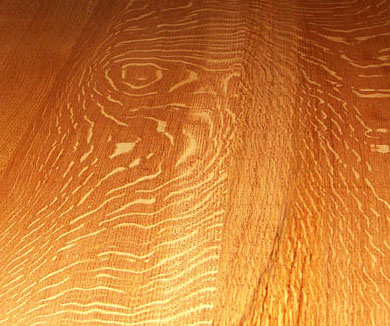All of the pieces offered by Fine Woodworks are made to order here in our Muskoka workshop. What follows is a guided tour of how I set about making a piece of furniture from rough lumber through to the final finish.
1. Sorting the Boards
Our rough lumber boards, consisting mainly of American Black Cherry and quartersawn White and Red Oak of varying thickness, are climatized to our shop for a period of time to ensure their stability to the environment. Then they are sorted for color, grain and width before being cut to rough length. I carefully choose the boards and match the grain for each piece of furniture I build. Every cut piece is marked and tracked to ensure symmetry of grain in the completed piece.
It takes great skill to “read” the boards, and predict the picture that will be created when they are placed together in the finished piece. A good eye will lend balance to the piece, while a poor grain match will cause a lop-sided look.
2. Milling
Once the boards have been cut to rough length, they are milled to their final dimensions. Great care is taken to maximize yield and to ensure that the components are dimensionally perfectly accurate, so that frames and carcasses assemble square and true.
3. Joinery
I use traditional joints to build my furniture because they continue to provide the strongest way to hold two pieces of wood together. The main joint employed in all my furniture is the mortise and tenon. With the aid of modern adhesives it provides excellent strength. The main application for this joint is where two components meet at right angles, typically at the junction of a rail and a leg.
For drawer construction I use a combination of traditional dovetails, finger joints or a drawer-lock joint to join solid maple drawer or baltic birch components. The choice of joinery and material used is determined by you and I during the design process as it will be a consideration when the price of the piece is determined.
4. Assembly
This is where all the effort involved in marking and tracking individual components really pays off. It is always exciting to see matched legs, panels and drawer fronts finally come together to create symmetry in the assembled piece. At this stage you can see why each piece of furniture is truly unique.
5. Finishing
Once the furniture is built, it is finished and prepared for delivery. During finishing I sand the surfaces to an incredibly fine 600 grit. On a practical level, finishing provides the necessary surface protection against a lifetime of daily use. On another level, finishing allows the wood to reveal its true character. The oils that I hand-rub into my pieces, penetrate the wood to reveal hidden colors and accentuate beautiful grain patterns.

